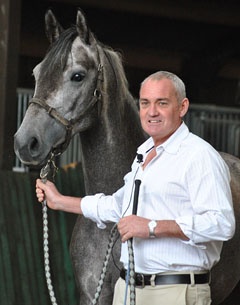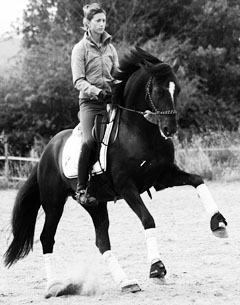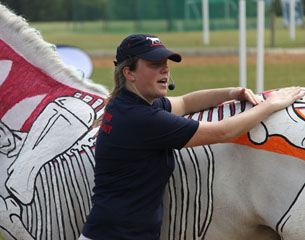
On 30 - 31 October 2011 the Global Dressage Forum will take place after the conference of the International Society for Equitation Science. The most important equine scientists in the world will be present and many will stay to attend the GDF. Some of them will give presentations during the GDF.
McLean: New practical research evidence: how horses can be learned to react less fearful
ISES President Andrew McLean, famous zoologist from Melbourne Australia, will present new practical research evidence to the visitors of the GDF. The title of his presentation is ‘Overshadowing: desensitizing horses to fear inducing stimuli’, which means in practical horse language that he will explain how horses can be learned to react less fearful on things as needles, clippers or the farrier.
The famous American ‘horseprofessor’ Hilary Clayton will speak about the canter, the changes that occur with training and the rhythm problems that may arise. She will give a unique demonstration with a horse that can show the typical young horse canter, the FEI collected canter and the canter pirouette. Clayton: “by looking more careful and studying the movement with high speed video we found out that things are different then we have considered them to be for a long time. This might even have consequences for rules and judging”. Next to the scientists the Global Dressage Forum program has many clinics by top trainers and riders such as Carl Hester, Charlotte Dujardin and Princess Nathalie zu Sayn Wittgenstein.
A Bridleless Grand Prix: Why Not?
 A discussion on the use of different bits in the top of dressage will be on the agenda of the upcoming Global dressage Forum (30-31 October, Hooge Mierde, Netherlands). A recent quote by dressage rider Richard Davison: “Why can we compete in the UK at GP level in snaffle and at FEI level just in a double bridle? if governing bodies don’t like tight nosebands then they have to supply alternatives. French Grand Prix rider Alizee Froment will go one step further. During the Global Forum she will ride her Grand Prix horse bridleless.
A discussion on the use of different bits in the top of dressage will be on the agenda of the upcoming Global dressage Forum (30-31 October, Hooge Mierde, Netherlands). A recent quote by dressage rider Richard Davison: “Why can we compete in the UK at GP level in snaffle and at FEI level just in a double bridle? if governing bodies don’t like tight nosebands then they have to supply alternatives. French Grand Prix rider Alizee Froment will go one step further. During the Global Forum she will ride her Grand Prix horse bridleless.
Alizee Froment is the French pony Chef d'Equipe and a young Grand Prix rider who competes at CDI level. Riding dressage horses is her profession. Alizee: “No sooner dismounted from one horse than I am up on the next. It is the daily routine of all professional riders”. Sometimes it is essential to break that routine, says Alizee. “It is the reason why one day, when my Grand Prix horse Mistral was saddled and waiting for me, I decided to leave the bridle aside and just puts his head-collar on. I needed to check that Mistral and I were still one. From the first tentative steps, I once more felt pleasure with blood running through my veins, found a taste of freedom and the immense confidence I had in him. More than anything, what came out was an optimal concentration between us, each on the other. In my eyes, dressage is the way toward perfect understanding and absolute harmony and working in the head-collar is a further step along this path. This is why I decided to work all my horses regularly in this way from my 5-year olds to my two Grand Prix horses ".
Alizee Froment will demonstrate her bridleless riding at the Global Dressage Forum and discuss with trainers, judges and an audience of international dressage experts from over 25 countries some of the following questions. Is bridleless riding compatible with ‘classical’ dressage? What about the technical riding details, how does one work like this, and how often, and how does it combine with usual double-bridle riding? And finally, to be discussed with the FEI representatives: to what extent should the rules of competitive dressage adapt?
Gillian Higgins shows the horse inside out - Back to Back
In dressage anatomical details are important. Dressage trainers and judges observe aspects as if the horse’s back is flexible, if the horse is bending, if the hindlegs are engaged .To make those observations more transparent, Gillian Higgins will paint a horse up with bones and muscles well visible on its skin during the Global Dressage Forum on 30-31 October in the Netherlands.
After the horses are painted one horse will be on the lunge line and a rider will ride the other and show things like how the suspensory ligaments in the hind legs stretch in piaffe, or even discuss where 'bend' is possible in the horses back. So when coaches or judges talk about 'bend the horse around the inside leg' is this actually possible?
 Gillian is professional Sports and Remedial Therapist specialising in assessing and mobilising muscles, improving performance and educating horse owners. With a passion for anatomy and biomechanics she gives lectures all over the world. She has given demonstrations at the World Equestrian Games in Kentucky as well as in Brazil and South Africa. She has written two popular books and one DVD. Gillian has represented the BHS in Sweden as part of the Leonardo Exchange programme. This has given her valuable insight into alternative methods of training and treatments, the best of which she incorporates into her own practices.
Gillian is professional Sports and Remedial Therapist specialising in assessing and mobilising muscles, improving performance and educating horse owners. With a passion for anatomy and biomechanics she gives lectures all over the world. She has given demonstrations at the World Equestrian Games in Kentucky as well as in Brazil and South Africa. She has written two popular books and one DVD. Gillian has represented the BHS in Sweden as part of the Leonardo Exchange programme. This has given her valuable insight into alternative methods of training and treatments, the best of which she incorporates into her own practices.
Hilary Clayton about ‘Canter’ changes that occur with training and the rhythm problems that may arise
The famous American ‘horse professor’ Hilary Clayton will speak at the Global Dressage Forum about the canter, the changes that occur with training and the rhythm problems that may arise. She will give a unique demonstration with a horse that can show the typical young horse canter, the FEI collected canter and the canter pirouette. Clayton: “by looking more careful and studying the movement with high speed video we found out that things are different then we have considered them to be for a long time. This might even have consequences for rules and judging”. During her demonstration she will use a horse that can show the typical young horse canter, the FEI collected canter and the canter pirouette. And a horse with a 4-beat canter and/or a lateral canter.
Program 2011:
Carl Hester & Charlotte Dujardin, Nathalie zu Sayn Wittgenstein, Kyra Kyrklund,
Alizee Froment (Grand Pix test in a head collar) Andrew Mclean (Overshadowing: desensitizing horses to fear inducing stimuli) Trond Asmyr (FEI update) Hilary Clayton (canter: the changes that occur with training and the rhythm problems that may arise) Gillian Higgins (horse-inside-out) Inga Wolframm (recearch project on visual aspects) Katrina Wüst & Wim Ernes (judging) Tim Hadaway (road to Olympic Games)
Don't Miss out on the 2011 Global Dressage Forum!! Order tickets www.globaldressageforum.com